
About the Author
Michael Trent is a noted expert in the field of American numismatics and collectible coins. Michael’s specialty is rare nickel coins, e.g., the value of buffalo nickels series of the early 20th century.
Michael’s attention to detail, in-depth knowledge of market trends and rare varieties enables him to determine exactly what is a buffalo nickel worth depending on the year, stamp and even partial indications on heavily worn specimens. His opinion is highly prized when it goes about determining buffalo nickel with no date value or identifying rare varieties like 3 legged buffalo nickel value.
Michael advises private collectors and investment funds to help them identify what buffalo nickels are worth money and which ones are undervalued. He also develops educational courses on coin valuation that raise questions: how much is a buffalo nickel worth today or are buffalo head nickels worth anything. All the above makes him a voice of authority in the numismatic community.
Creation and Historical Context
At the beginning of the 20th century America was going through a time of change: the country was rapidly developing, a new national identity was forming, and even coins began to reflect this process. People were trying to redefine familiar symbols and seeking to anchor their own culture and uniqueness. All of this combined to create one of the most recognizable coins in the United States and, subsequently, a serious increase in Indian head buffalo nickel value.
Coin Symbolism
- Indian head on the obverse – a collective idealized image of an Indian warrior based on the features of real representatives of indigenous peoples Iron Tail, Two Moons and possibly John Big Tree. All this is made to show respect for Native people and their role in the history of the United States.
- The bison on the reverse is a symbol of the American prairie and the power of nature. There is a theory that Fraser used the famous Black Diamond bison from Central Park Zoo as a model.
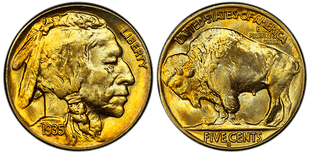
Technical Characteristics
| Parameter | Value |
| Metal | 75% copper, 25% nickel |
| Weight | 5.0 grams |
| Diameter | 21.2 mm |
| Thickness | 1.95 mm |
| Type of edge | Smooth |
| Denomination | 5 cents |
| Designer | James Earl Fraser |
| Inscription E PLURIBUS UNUM | On the reverse, above the back of a buffalo |
| Coinage features | High relief, quickly erased |
Type 1 and Type 2
There are two main types of these coins:
- Type 1 (1913) – the buffalo stands on a mound and the inscription FIVE CENTS is right on top of it (often erased).
- Type 2 (late 1913 through 1938) – the inscription was moved lower to a notch below the ground line, to increase readability and durability.
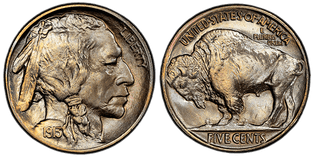
Type 1 is considered more fragile to wear, but also more sought after. Questions like “how much is the buffalo nickel worth” or “buffalo nickel worth money” are constantly raised among collectors, especially when comparing the two types.
Years of Minting and Stop Issue
The coins were minted from 1913 to 1938. Over time, however, it became clear that the high-relief design would wear off too quickly in circulation – especially the date and denomination inscriptions. This led to complaints from banks and the public, and in 1938 Buffalo series was replaced by another one.
However, even a lost date on a copy does not deprive it of its value. Surely you have heard about Indian head dateless buffalo buffalo nickel value no date, because collectors are still interested in Indian head buffalo nickel no date value.
This is because a piece that was in circulation for a long time may be worn on the high points – the minting date, etc. The value of buffalo nickel with no date is slightly higher than regular worn examples, but considerably lower than ones that kept their date. The only exception is the significant no date buffalo nickel value for coins with other signs of rarity (e.g., well-preserved buffalo “steps”)
However, despite some nuances, the coin’s popularity did not fade. Many people still search for what year buffalo nickels are worth money, and ask the question, is a buffalo nickel worth anything now? And the answer is usually yes, especially if it is a rare year, good condition or a non-standard minting variant.
Key Release Dates, Features, and Value of Buffalo Head Nickels
Among all nickels, some issues stand out in particular – both in rarity and value. These coins are often sought after by collectors who hear about the high value of Indian head buffalo nickel and want to know exactly which buffalo nickels are worth money.
Below is a table of the most prominent pieces so you can easily understand how much are buffalo nickels worth today, depending on the coin grade.
Buffalo Head Nickel Value Table by Grade
| Variation | Mintage Figure | G4 ($) | VF20 ($) | MS63 ($) |
| 1913‑S Type I | 2,105,000 | $50 | $100 | $450 |
| 1913‑S Type II | 1,209,000 | $125 | $250 | $1,500 |
| 1913‑D Type II | 4,156,000 | $40 | $90 | $400 |
| 1914 4‑over‑3 Overdate | — | $302 | $618 | $6,052 |
| 1916/16 Doubled Die Obverse | — | $5,251 | $13,902 | $144,593 |
| 1918/7‑D Overdate | — | $1,713 | About $4,500 | $24,000 (AU58/MS63) |
| 1921‑S | 1,557,000 | $40 | $100 | $500 |
| 1924‑S | 1,437,000 | $30 | $59 | $3,354 |
| 1926‑S | 970,000 | $60 | $180 | $7,500 |
| 1935 Doubled Die Reverse | — | $50 | $150 | $2,000 |
| 1936‑D 3½ Legs | — | $539 | $1,770 | $26,000 |
| 1937‑D Three‑Legged | — | $550 | $1,200 | $5,000 |
* This Buffalo nickel value chart by year (2024-2025) is based on data from USA Coin Book, PCGS and APMEX. Please note that it is recommended to double-check the current value as prices may vary depending on the condition of the particular coin, its market liquidity, certification and demand.
Thanks to this data, you now have an idea of “what are buffalo nickels worth?” and clearly shows that even modest five-cent denomination can grow into tens of thousands of dollars. Now let’s take a closer look at each of the key coins to see exactly why they are so valuable among collectors.
Key Date Examples in Detail
There are issues in the history of these coins that are especially cherished by collectors because of their rarity, unique minting errors, or limited mintage. Below we will talk about these variants in detail.
1913‑S Type I

This issue is the first version of the design where the animal stands on a rising hill. The coin was not minted until early 1913 at the San Francisco Mint. Due to the high relief of the reverse, the details were quickly erased (especially the date).
This is what makes specimens with clear elements especially valuable. Collectors are often interested in how much is a buffalo nickel worth with no date and are eager to get their hands on this particular option for its artistic expression and rarity.
1913‑S Type II
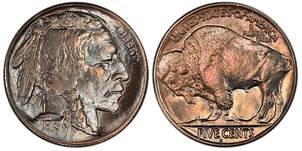
After design changes, the bison began to stand on a flat platform – thus the new standard of five-cent coins was born. The San Francisco version is considered one of the rarest. Even in poor condition this Indian buffalo nickel value remains high. In AU condition or better, it becomes a worthy piece in any collection.
1913‑D Type II
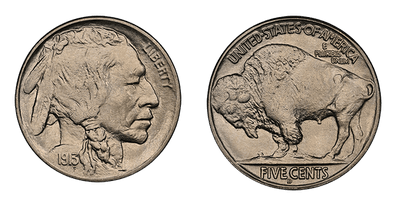
A Denver coin with a similar design. Despite the higher mintage, it is extremely difficult to find specimens with readable details. This coin is of interest to both novice and experienced numismatists, especially the ones who wonder are buffalo nickels worth anything in the long run.
1914 4‑over‑3 Overdate
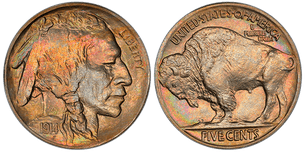
An early variety of the coin with an overlap of the numeral 4 with the triple in the date. The minting error is clearly visible, especially under magnification. Such specimens become especially desirable for anyone studying rare pieces of the series or looking for interesting errors to add to their collection.
1916/16 Doubled Die Obverse
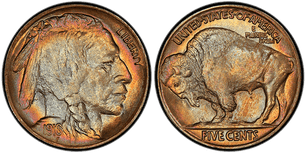
One of the most famous varieties with the last three numbers of the date doubled. A real find for someone curious about what’s the value of a buffalo nickel (especially one with known errors). PCGS or NGC certified specimens regularly appear in the catalogs of leading auctions.
1918/7‑D Overdate
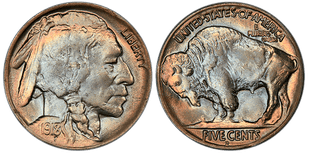
This is a rare variation with a date imposed – 1918 over 1917. Despite its relatively small mintage, the variation was discovered years after issue. Today, this error is among the key specimens and is not last on the buffalo Indian head nickel value lists.
1921‑S
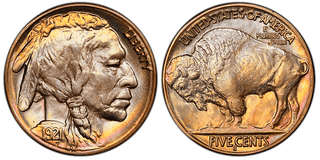
One of the lowest circulations among regular issues. Is the buffalo nickel worth anything? Yes, if we are talking about this particular variety of coins. Specimens with bright details easily attract attention at auctions like Stacks Bowers, where this nickel buffalo value can reach several hundred dollars depending on the grade of the coin and its features.
1924‑S
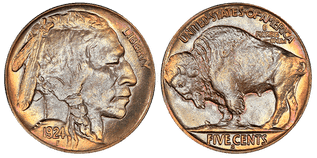
A rare San Francisco issue that continues to interest collectors, a great find and a worthy addition to any collection for anyone who keeps track of how much buffalo nickel worth and changes with time. Even specimens with moderate wear can often exceed your expectations for value.
1926‑S

This variant is one of the hardest to find in excellent condition. MS specimens are rare to the point where they easily rival the more famous minting errors. Information on these coins can often be found in the Hudspeth and Numismatic News databases.
1935 Doubled Die Reverse
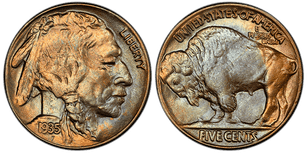
A late issue valued for its distinct duplication on the reverse – especially in the inscriptions “FIVE CENTS” and “E PLURIBUS UNUM”. For numismatists researching this buffalo nickel e pluribus unum value this issue becomes an important part of the study of late minting errors.
1936‑D 3½ Legs
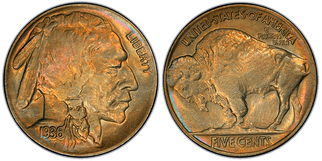
A known variety with a partially missing bison leg. The error occurred due to excessive polishing of the press. This is an excellent example of how an unusual detail can turn an ordinary coin into an object of hunting for people interested in worth of buffalo nickel in non-standard designs.
1937‑D Three‑Legged

That legendary variety where one of the bison’s front legs is completely missing. Of course, this is one of the most recognizable errors in the entire series. Even in VG or F condition, this coin may be worth more than many earlier issues.
Is the three legged buffalo nickel value significant? Of course, and even it reaches several thousand dollars. However, this is not a barrier for people building collections on the basis of known errors.
Other Valuable and Erroneous Varieties of the Coin
While the “kings of the score” are the well-known minting errors and interesting variants we discussed above (e.g., varieties like the three-legged buffalo or the double date), other confirmed minting errors are also confirmed.
Some of these are caused because of equipment failures, others are due to rush at the mints. What is especially nice for collectors – even a non-perfect coin can be worth a lot of money.
Below for your convenience is a table with other confirmed errors, their brief description and approximate value in collectible condition. For ease of comparison, a normal specimen without errors is also included so you can assess what buffalo head nickels worth if they do not contain rare details.
| Mistake | Description | Estimated value (good grades) |
| Regular coin | 1935-S example with no errors. A typical specimen from the San Francisco Mint. | $1 – $4 |
| Double strike | 1936-D coin received a second strike with partial offset. Double borders and duplication of details are visible. | $80 – $250+ |
| Off center | 1935 Philadelphia off-center piece, strike offset by about 15%. Part of the image is missing or cropped. | $60 – $200+ |
| Weak strike | 1937-S example, poorly expressed inscriptions or details, e.g., “E PLURIBUS UNUM”. | $15 – $60 |
| No date | No- date example (probably 1920s, Philadelphia) – date erased, possibly a faint strike. | $0.50 – $3 (up to $40+ with other features) |
| Grease stamp | 1934 D, date and/or elements are severely unreadable due to clogging of the die. Also known as “Ghost Date” pieces. | $10 – $45 |
| Excessive polishing | 1938-D over-polished reverse coin, stamp is excessively polished – part of the inscription is missing, e.g., “FIVE CENTS”. | $25 – $75 |
| Stamp rotation (reverse) | 1935-S Rotated Die (~90°) – axis rotated, reverse oriented vertically with horizontal obverse. | $40 – $150+ |
Now you know what varieties of nickels there are and which errors are valued the most. But understanding what is the value of a buffalo nickel depending on the year and variety is only the tip of the iceberg. It is equally important to know how to distinguish an original from a fake and not to lose its numismatic value over time.
Fakes and Authenticity: Keep Your Coin Value
Unfortunately, it is the most valuable variants that are most often counterfeited. This also applies when collectors try to find out how much are buffalo head nickels worth and come across fraudulent offers – after all, the difference between a fake and an original can be hundreds or even thousands of dollars.
How to distinguish a fake from the original:
- Study the shape and proportions of the bison. In the original, they are clearly balanced.
- Pay attention to the date – fakes often have a strange stylization of numbers.
- Use a magnifying glass to analyze the lettering – fakes may have blurred edges.
- Fakes may have a strange luster or the wrong alloy.
Be careful – sometimes fakes also involve attempts to imitate date erasure: owners specially “age” coins to pass them off as rare dateless specimens.
FAQs
Can I say how much is my buffalo nickel worth, if I don’t have a special skill?
If you are unsure of a coin’s value, start by assessing its condition, date and possible rare features. The Coin ID Scanner app makes it easy – simply scan the coin and find out how much is buffalo nickel worth today.
Should the coin be valued on metal value alone?
No, while buffalo nickel melt value is simply the price of the alloy (copper and nickel), the true value of these coins is usually determined by rarity, condition, and minting errors. Even a worn specimen can be worth more than its “metal” price.
What factors can affect how much is an Indian Head Buffalo Nickel worth?
The value of the piece depends on many factors, but the main ones are its condition, rarity, mintage and errors. For example, a well-preserved specimen or rare variety can increase its value significantly, while a specimen with damage or worn parts will be worth much less.